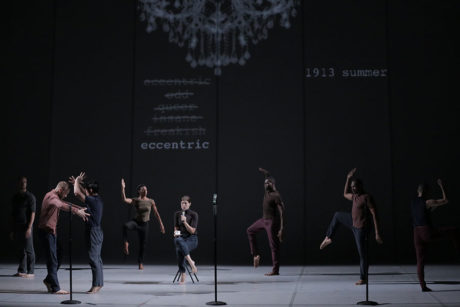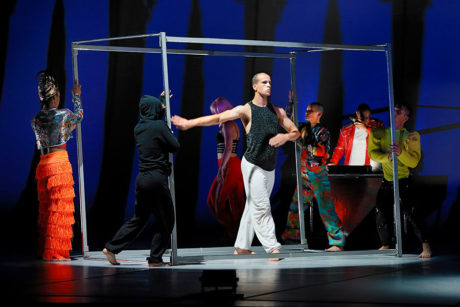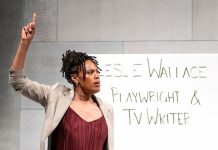It’s too simplistic to call Bill T. Jones a choreographer, although that’s been his stock and trade for more than 40 years. This past week his Analogy unfolded as a trilogy, over three nights at the Kennedy Center’s Eisenhower Theater, where Jones later held court after each show, taking questions from the audiences and posing his own.

Over the course of his lengthy and sometimes provocative career as a dancer and dancemaker, he has moved steadily into his role as the dance field’s formidable moralist. Jones has long used dance to make his audiences think about the hard issues facing our contemporary society. Back in 1991, he unapologetically dealt with the race card in his sprawling opus that closed with dozens of nude dancers filling the stage, Last Supper at Uncle Tom’s Cabin/The Promised Land, which also faced down faith and freedom. And in 1994, he faced death and dying in Still/Here, by mining the hopes and fears of people facing a terminal illness setting their movement on his professional dancers.
A prominent New Yorker critic declared it “victim art” and it made Jones reframe his work for a time. His Chapel/Chapter (2008) wrestled with questions of guilt, innocence, justice, and mercy in the wake of a horrific crime. He returned to race and politics in Fondly Do We Hope … Fervently Do We Pray (2009), a historical biographical dance/theater work based on the life and fraught legacy of Abraham Lincoln, seen through Jones’s own unrelenting filter.
This one-time student of and poster child for postmodern dance – which stripped away technical movement and narrative for a clean slate – still imbues his choreographic projects with John Cage-like rules, structures and chance settings from the post-modernist playbook. Yet, he revels in digging deep and won’t pursue a piece to its fullest without a satisfying unanswered question for him to turn over and over. In fact, Saturday night he stated, “it’s the quality of our questions” that keeps him engaged and making work over the course of his long career.
In Analogy, Jones wrestles with trauma, memory and overcoming and how those life-changing events can haunt lives as past and present collide. In Analogy/Dora: Tramontane (2015), which I saw three years ago at George Mason University, Jones takes as his subject his mother-in-law Dora Amelan, a French-Jewish nurse who worked in the underground in Vichy France, against the Nazis and Vichy collaborators. Her story is compelling, beautiful and lovingly told through movement, images, taped oral history interviews Jones did with Amelan, and shape-shifting set pieces that come together and pull apart like a 3-D puzzle. Dora’s story and her courage and gusto, though, ultimately felt more compelling than the accretion of all the parts Jones connected.
In Analogy/Lance: Pretty aka the Escape Artist (2016), Jones shares the story of his nephew Lance T. Briggs’s challenging and tragic life as he goes from a scholarship student at the San Francisco Ballet with aspirations to dance with his uncle’s company to a life of sex and drugs on the streets to prison and paralysis. It’s a sad tale of potential lost, and slow-to-come self-knowledge. Here the gritty worlds of clubs, streets, and anonymous sex-tinged encounters are interspersed with pulsing moments of dance-til-you-drop partying. The spoken and recorded narrative and dialogue was taken from recorded phone calls the uncle and nephew had over the course of a few years.
The final segment, Analogy/Ambros: The Emigrant (2017), is the most diffuse, drawing inspiration, text and story from novelist W.G. Sebald’s novel The Emigrants, a story told from varying perspectives. Here Jones explores form over story, restructuring the décor and pieces and elements of Analogy’s other sections into another moving puzzle of shapes, images, words and personal commentaries from dancers, narrators, and song.

Dance becomes one element in a quilt where shifting but thematic stage design by Bjorn Amelan (Jones’s husband and son of Dora), video and projection (Janet Wong) and musical composition (Nick Hallett, who also offers his tenor voice from the orchestra pit) carry equal and essential weight across the three approximately 80-minute evenings. The white Marley flooring décor designer Amelan hung from the back rafters, like the blank white paper of a photographer’s backdrop, places the action in an artificial space. The white drops and floor afloat amid a blackened void of the surrounding universe. This floating décor renders each story timeless.
The dancers both serve and tell each story through spoken monologues and dialogues and sung-through passages, both in Dora and Lance culled from oral histories Jones recorded. Using handheld microphones that they pass back and forth – forcing the audience to become conscious observers and not suspend disbelief by being seduced into a story – the dancers become interchangeable characters, observers and even pieces of décor amid a moving canvas. Particularly in Lance and Ambros, songs sung or sampled intersperse into a gorgeous score, which has taken inspiration from Schubert’s aching funereal lieder “Nachtstueck” and “Alinde,” but also include French folk and partisan songs, excepts from 1980s club tracks by Luther Vandross and others, and original song cycles that put passages from Sebald’s writing to soaring voices – both the dancers who sing and Hallett. That Jones drew such elegant and effective vocalizations from his dancing cast is remarkable.
The three evenings, each about 80 minutes, are also pulled together by the stage elements – an old-fashioned cot, a series of panels and rods that become various house, hospital, prison and other settings as the dancers move them around folding, hoisting, shifting and sliding them like a Rubik’s cube until they change shape and appearance. In Ambros, the puzzle-like house pieces become a shifting screen on which dancers’ self-shot videos of their responses to the text get played, while live bodies weave in and out of the screen space.
The question that continues to tug for me, though, is: “How is the choreography?” In each part, Jones’s slippery, formalist shape-oriented movement style is evident. He also draws occasionally from vernacular dancing – a folk-dance motif in Dora and the club and street-dance moves that illustrate Lance’s world. Additionally, gesturally derived moments are interspersed with clean-lined phrases of Merce Cunningham-esque bodies linearly moving in space. Dance, as Jones might be the first to say, is a universal language. But in Analogy, I didn’t find a great deal of movement invention that was distinctive and driven by the individual stories.

The most specific movement comes from lean, lanky Vinson Fraley, who plays Lance and his Pretty alter ego as a voguing, catwalking seductress, sashaying around in red socks. There’s an archness and lusty joy in Lance that draws from the club, hip hop, and street dance cultures that contrasts with the sense of loss and rumination as Lance loses his way. There, the dancers, clad in costume designer Liz Prince’s hoodies, tracksuits and, later, a collection of white dance attire, enjoy the looser, more relaxed jogging and freestyling. For Ambros, the dancers project a feeling of restraint, as if they’re encased in buttoned-up wool suits, though their costumes are again stretchy dance togs. And then compact Carlo Antonio Villanueva as Ambros lets loose with an astonishing floor-bound solo of visceral feeling. But I can’t say that any of these stories could not be well, or even better, told without choreography.
Here Jones serves as a director, culling and pulling from theater, story, design and music, all of which gets processed into three connected yet not wholly wrought evenings. The dance serves the pieces, but is not essential to them and it is less memorable than the visuals and music. Jones articulated that his aim, particularly in Ambros, was to find a way to represent the poetry of Sebald’s writing visually and viscerally. Thus, the dance enhances at times, and illustrates, at other times – especially when Jones wants to place viewers in a particular place like a nightclub or a hospital – but is not at all essential to any of the narratives in the way his earlier works choreographically unspooled on an elemental level. Each of Analogy’s three tales is equal parts narratively compelling, visually fulfilling, aurally engaging and, alas, choreographically frustrating – slippery and unspecific.
Jones at 67 has graduated from the dance field’s choreographic provocateur to our wise, gray sage. This later-career trilogy, not opus material, contains a sparseness, a sense of summing up in his need to wrestle down memory and his own, perhaps failed relationship with his nephew, in particular. There’s a didacticism and forced instructive sensibility in these works. While each work can stand alone, together they’re a matched set. Each an accretion of disparate parts, of stories and images, words and music, they don’t feel like fully formed units. As each journey – for Dora, for Lance T. Briggs and for Ambros and his companion Cosmos to turn of the century Jerusalem and Turkey – proceeds, it’s hard to feel deeply committed to these characters. Their stories are beautiful, inspiring, tragic, and poetic but much of the sheen in “Analogy” rests in the collaborative contributions and the challenging performances of the dancers.
There’s so much art-making going on on stage that the hard questions, the ideas, the wrestling, get lost in the action, drawing the eye to the form and the structure rather than the heart to the depth of meaning. Frailty and fragility of life, of relationships, of memory, are the threads that stitch this quilt together, yet this cycle of three works never warms for me.
Bill T. Jones/Arnie Zane Company performed Analogy/Dora: Tramontane March 28, Analogy/Lance: Pretty aka the Escape Artist March 29 and Analogy/Ambros: The Emigrant March 30, 2019, at the Kennedy Center’s Eisenhower Theater – 2700 F Street NW, Washington, DC.





Thanks for another magnificent article. The place else could
anybody get that type of info in such an ideal approach of writing?
I have a presentation subsequent week, and I’m at the search for such info.
Hi Lisa. I just found this What fztastic writing. Thank you.
I am looking for material(especially video) on RITE by Jones/Zane dance company. Im doing a presentatin on Human Sacrifice….Can you help? In anticipation.
Toda Raba
Chag Hanukka Sameach
Judy.